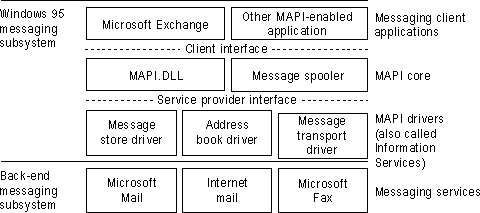
The Windows 95 messaging subsystem architecture provides power and flexibility. The core of the subsystem is MAPI, an industry standard that enables applications in Windows 95 to interact with many different messaging systems using a single interface. The MAPI architecture defines messaging clients, such as Microsoft Exchange, that interact with various messaging service providers, such as Microsoft Mail and Microsoft Fax, through MAPI, as shown in the following diagram:

MAPI divides messaging applications into four components:
MAPI subsystem.
Messaging client applications communicate with service providers through the MAPI subsystem. The client interface interacts with the MAPI subysystem to access MAPI-compliant service providers.
The client interface is one of two major functional interfaces in MAPI; the other is the service provider interface. Messaging applications that require messaging services call functions in the client interface. For example, client applications can call MAPI functions to send, receive, save, and read messages. These functions are sent to the MAPI subsystem, which calls corresponding functions within the provider interface. Service providers then implement service-provider functions to perform the indicated actions for the client. The message spooler queues outgoing messages and routes incoming messages to the proper message store folder.
Messaging clients.
Messaging client applications communicate with MAPI service providers through MAPI interfaces. Messaging client applications can be divided into three general categories:
For information about creating a messaging client, see the Win32 Software Development Kit for Windows 95 and Windows NT and the MAPI 1.0 Developer's Guide.
Messaging service providers.
A messaging service provider can include multiple message stores, address books, and messaging transport providers.
MAPI selects between message store and messaging transport providers, as necessary, and merges the address books presented to it, so the client application sees one combined address book interface. Other vendors can add or replace messaging service providers to enable the Microsoft Exchange client to work with their mail systems.